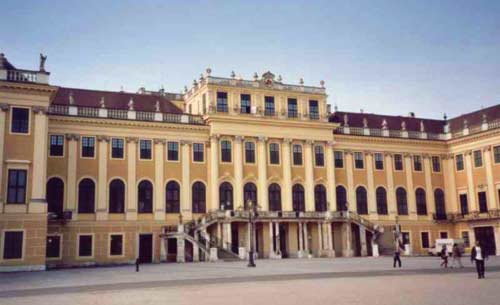Schloss Schönbrunn Palace
-
Construction time: 1696 - 1700
-
Location: Vienna, Austria
Schloss Schönbrunn, the summer palace of the Austrian-Hungarian monarchy, is one of the largest and most magnificent Baroque palaces in Central Europe. Even so, the palace was just a tiny fraction of what architect designer Johann Bernhard Fischer von Erlach dreamed of in the beginning.
Fischer - "imperial architect and emperor" of Emperor Leopold I, is the main figure in the development of Baroque art in Austria. In 1671, at the age of 15, he went to Italy and stayed there for 16 years, studying the relics of Greece and Rome and the works of Borromini, Bernini and Fontana. He is also associated with French architects and learns their work through woodblocks. When he returned to Austria in 1687, he realized that Vienna was recovering after being surrounded by Turkey , confident and ready for ambitious construction projects. Soon after, he found important sponsors and he entered the palace, becoming a tutor to the son of Emperor Joseph, later Joseph I. In 1696 he was elevated to the nobility and awarded the title "von Erlach". In 1704 he traveled to Germany, Holland and England to meet Christopher Wren.
Diagram and reality
Perhaps for Joseph, Fischer von Erlach outlined the first diagram of Schönbrunn. The date is unknown, but the scale is so large that he cannot figure it out.

Schloss Schönbrunn Palace is spacious, outside Vienna
designed by Fischer but Nikolaus Pacassi redesigned largely in the 18th century (Photo: musik-hochzeit)
When the idea of the Holy Roman Emperor's ideal residence arises, the palace was built on a scale larger than Versailles by Louis 14. The massive palace had to be built on top of Schönbrunn hill outside Vienna . The entrance between the two copies of Troy's Column in Rome leads to a large open-air space for jousting, on the side of the tanks with sprinklers. Behind the ground emerges a strip of land by creating a steep slope by a gentle passage following the park in Versailles. At the top, the palace itself is divided into a central eye surface and connected courts by walls of a quarter.
Started in 1696, although Schönbrunn was built, it was definitely a cropped version, but still wide open in any standard. Recognizing the large courtyard, along with 2 taps, the facade still lingered with Versailles, with the hall in the middle and the walls for the Emperor and Queen on the left and right. Joseph I succeeded his father in 1705 and died in 1711, while the palace was unfinished.

Large gallery in Schloss Schönbrunn Palace (Photo: imagevienna)
Fischer's interior creates a consistent impression, full of finished plaster products and paintings painted by the top artists' ceilings . However, there is no need to talk about them, because the whole palace was basically redesigned by Nikolaus Pacassi in the 18th century, he was the architect of the royal court of Queen Maria Theresa. Pacassi also changed the interior, raised the top floor, inserted a mezzanine and added to the northern facade a row of Ionic columns - thus seriously violating Fischer's vertical section.
Actual data:
-
Length: 190m
-
Park area: 1,200 x 1,300m
-
Number of rooms: 1,400
 The tunnel is made of Schloss Schönbrunn (Photo: yasui.anjiro)
The tunnel is made of Schloss Schönbrunn (Photo: yasui.anjiro)
Maria Theresa's Palace.
However, Pacassi's interior is an important Rococo art piece, thus reducing Fischer's design flaws . The large corridor leads to the middle of the facade, before Fischer used it as a hall. The wall head column is decorated with a decorative leaf cover, compared to the wall and gilded mirror. The previous green staircase was Fischer's dining room, retaining only the ceiling painting during his time, Joseph I style painting as Sebastiano Ricci's god.
"Million rooms" have rosewood panels with 260 Indian miniatures painted on premium parchment describing life in the court of Mughal emperors. The room is named after Napoleon, where he spent the night in 1805 and 1859, with the 18th-century Brussels warfare carpet hanging. "Vieux-Lacque" room is Maria Theresa's private room, combining Rococo art Vienna's with black painted panels of East Asia. The Chinese room was circular, the former room for Joseph I, also Chinese lacquer, was decorated with Rococo art.
Schönbrunn Park also created an impression like a palace, elaborately trimmed hedge rows forming the wall of ornamental trees as high as a 3-storey building. Among the most famous works is Gloriette, which is a series of immortal neoclassical columns designed by Ferdinand von Hokenberg, and Nha Co is equally massive built for the first year of Franz Joshp. 1882.
- Admire the 10 most magnificent palaces in the world
- Discover the world's largest gold-plated palace of the king of Brunei
- Explore the magnificent Royal Palace of Japan
- The Crystal Palace - The Crystal Palace
- Uncover the mystery of childbirth in the old palace ban
- Ruins of Qin Shihuang Palace surfaced on the beach
- Find the palace of Ode in the epic of the Morning
- Discovering vestiges of the palace during the Le So period in Thang Long Citadel
- Where is the bow in the Forbidden City?
- The 3000-year-old palace suspects King Solomon
- Found the palace in the tomb of Qin Shihuang
- Rare photos of the 130-year-old Mandarin Palace are in danger of being knocked down in Saigon

 Norway built the world's tallest wooden tower
Norway built the world's tallest wooden tower Kremlin
Kremlin Ashurbanipal: The oldest royal library in the world
Ashurbanipal: The oldest royal library in the world Decoding the thousand-year construction of Qin Shihuang shocked the world
Decoding the thousand-year construction of Qin Shihuang shocked the world